分子生物学英文课件
合集下载
生物化学与分子生物学 ppt课件

学科
杂志总数 >10
平均引用指数
>30杂志数
总论 化学 物理 数学 生物
3 2 5 1 38
17.8 11.8 22.0 18.2 19.1
0 0 2 0 7
• 下面让我们来看一看从1910年到现在分子生物学史上的一 些情况。
1910年,德国科学家Kossel获得了诺贝尔生理医学奖, 他首先分离出腺嘌呤、 胸腺嘧啶、和组氨酸。 1959年,Uchoa发现了细菌的多核苷酸磷酸化酶,成 功地合成了核糖核酸,研究并重建了将基因内的遗传信息 通过RNA中间体翻译成蛋白质的过程。而Kornberg则实现 了DNA分子在细菌细胞和试管内的复制。他们共同分享了 当年的诺贝尔生理医 学奖。 1962年,Watson和Crick因为在1953年提出了DNA 的反向平行双螺旋模型而与Wilkins共享诺贝尔生理医学奖, 后者通过对DNA分子的X射线衍射研究证实了Watson和 Crick 的DNA模型。
PCR、转基因(transgene)、基
因剔除(gene knock out)等
核酶(ribozyme)的发现 人类基因组计划(human genome project) 后基因组研究(蛋白质组学proteomics)
• 1985年5月,加州大学校长Robert提出测定人
类基因组全序列 • 1986年3月,诺贝尔奖获得者Dulbecco首次提 出人类基因组计划的概念 • 1990年10月,正式启动人类基因组计划 • 1999年7月,中国科学院遗传研究所承担了1%
1993年,Roberts和Sharp由于在断裂基因方面的工 作而荣获诺贝尔生理医学奖。 Mullis由于发明PCR仪而与 第一个设计基因定点突变的Smith共享诺贝尔化学奖。
(推荐)《分子生物学全套》PPT课件
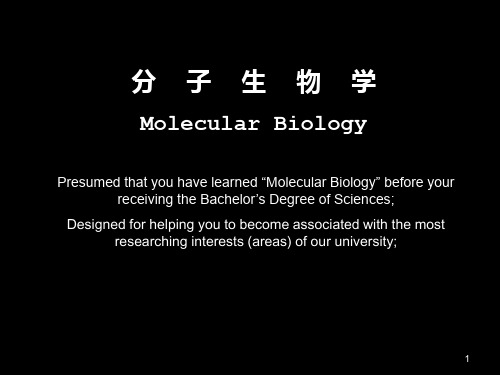
Sulfurylase
In one tube in one machine Automated process Light strength is absolutely proportional to ATP, thus to PPi to base on the template
ATP (+ sulfate)
8
Reads, not template
The recorded is the sequence of dNTP flow; FLOWGRAM; Reads averaging 400 bases; Homopolymer repeats up to six nucleotides; The number of dNTPs added is directly proportional to the light signal, with fluctuation.
9
template
Primer Machine + Kit
DNAn + dNTP
extension
polymerase
DNAn+1 + PPi
Over supplied
+
adenosine-5’-phosphosulfate, APS
dNTP
Apyrase
dNDP + dNMP + Pi ADP + AMP + Pi
PCR amplification (Chain extension) Emulsion breaking Template dissociation
Emulsion PCR: 1 – 2 - 2n; synchronically,
大学分子生物学经典双语课件

2.1.2.2 Conformation polymorphism of the double helix
Alternative doublehelical structures of DNA
Base Obliquity
helix rise per base pair
bp number per turn
biological activity changed (even lost); viscosity decreased,粘度 solubility decreased,溶解度 Hyperchromicity: the absorbance of ssDNA is greater than that dsDNA.增色 concentration = 50μg/ml: dNTPs A260 = 1.60 S.S DNA A260 = 1.37 D.S DNA A260 = 1.0
2.1.3
Triplex DNA
1953, Watson & Crick proposed D.S DNA model and found many redundant hydrogen bonding donor and receptors along big grooves. 1957, Felsenfeld proposed T.S DNA concept
transferring the other dsDNA through the break.
Type I topoisomerase
Type II topoisomerase
Contents
1
2 3 4 5 6 7
Structure of DNA Denaturation, renaturation and hybridization
分子生物学ppt课件
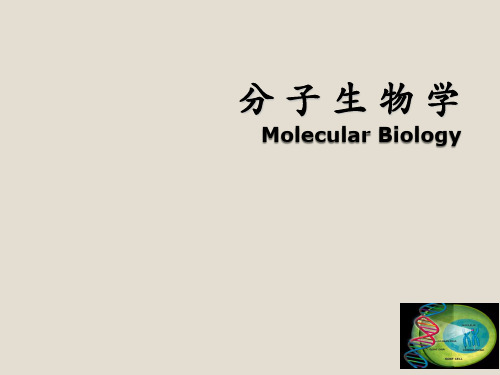
基因组大小(Mb)
0.58 1.83 4.20 4.60 13.50 12.50 466 165 97 2700 3000
基因数
470 1743 4100 4288 6034 4929 30000 13601 18424 30000 25000
染色体数*
无 无 无 无 16 16 21 4 6 20 23
包括:
结构基因组学
功能基因组学
三个亚领域.
比较基因组学
28
29
一、病毒基因组 二、原核生物基因组 三、真核生物基因组
30
一、病毒基因组
基因组(genome) 1个配(精子或卵子),1个单倍 体细胞或1个病毒所包含的全套遗传物质的总和。病毒核酸 或为DNA或为RNA,可以统称为病毒染色体。
完整的病毒颗粒具有蛋白质外壳,以保护病毒核酸不 受核酸酶的破坏,并能识别和侵袭特定的宿主。
分子生物学
Molecular Biology
1
What is Molecular Biology?
分子生物学是从分子水平研究生命现象、生命规律和生命本质 的学科。
核心内容是从分子水平研究基因和基因的活动,这些活动主要 通过核酸和蛋白质的活动来实现。
医学分子生物学主要研究人体生物大分子和大分子体系的结构、 功能、相互作用及其与疾病发生、发展的关系。
16
三、基因的结构特点和分类
基因的结构
结构基因:编码区序列(coding region sequence )
在细胞内表达为蛋白质或功能RNA的DNA序列
转录调控序列:非编码序列(non-coding sequence)
基因表达需要的调控区(regulatory region)序列, 包括启动子(promoter)、增强子(enhancer)等。
英汉对照分子生物学导论课件Sample

Vocabulary of Day 3 (4/4)
anti-parallel base-stacking major groove minor groove
nanometer denature
denaturation absorbance
absorb adsorb
反向平行的 碱基堆积 (DNA)大沟 (DNA)小沟 纳米 变性(动词) 变性(名词) 吸收(名词) 吸收(动词) 吸附
1) Nitrogenous base / 含氮碱基
2) Sugar / 糖
No oxygen here !
Ribonucleotides and deoxyribonucleotides 核糖核苷酸 与 脱氧核糖核苷酸
3) Triphosphate / 三磷酸
NH2 65 1N
7 N
8
O
O
2.4 DNA in the Cell
2.4 细胞中的DNA
2.5 RNA (Ribonucleic Acid)
2.5 RNA(核糖核酸)
2.6 Experiments
2.6 实验研究
Vocabulary of Day 3 (1/4)
nucleic acid genetic material
inherit nucleotide nitrogenous base triphosphate
1.1
Tm
1.0 65 70 75 80 85 90 95
Temperature
Light absorbance by DNA
DNA对光的吸收
dsDNA
ssDNA
2.1 Properties of a Genetic Material
分子生物学英文课件:Eukaryote gene and genome
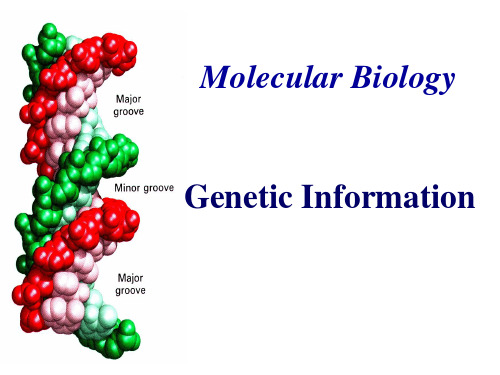
Exon: segments of eukaryotic gene (or of the primary transcript of that gene) that are saved as part of a functional, mature mRNA, rRNA or tRNA molecules. Intron: segments of eukaryotic gene (or of the primary transcript of that gene) that are removed by splicing during RNA processing and are not included in the mature, functional mRNA, rRNA, or tRNA.
Repetitive sequences
高度重复序列(highly repetitive sequence) 中度重复序列(moderately repetitive sequence) 单拷贝序列(single copy sequence)或低度重复序列
(一)高度重复序列(highly repetitive sequence)
➢ Have unique structure elements
基因 -N
转录起点
+1
结构基因区
调控区
mRNA 5’
AUG
翻译起点
蛋白质 N
转录 翻译
转录终点
+N
UAA
3’
翻译终点
C
Gene expression: DNA→mRNA→Protein DNA →RNA
mRNA
mRNA
转录
tRNA
rRNA
Repetitive sequences
高度重复序列(highly repetitive sequence) 中度重复序列(moderately repetitive sequence) 单拷贝序列(single copy sequence)或低度重复序列
(一)高度重复序列(highly repetitive sequence)
➢ Have unique structure elements
基因 -N
转录起点
+1
结构基因区
调控区
mRNA 5’
AUG
翻译起点
蛋白质 N
转录 翻译
转录终点
+N
UAA
3’
翻译终点
C
Gene expression: DNA→mRNA→Protein DNA →RNA
mRNA
mRNA
转录
tRNA
rRNA
分子生物学英文课件:Chapter2 Metabolism of Nucleotides

* AMP, GMP, dAMP, dGMP IMP, XMP *ADP, GDP, dADP, dGDP *ATP, GTP, dATP, dGTP
• Anabolism
*de novo synthesis pathway *salvage pathway
• Catabolism
de novo synthesis of purine nucleotides
PRPP synthetase
(Ⅰ)
1
(Ⅱ)
.
9
amidotransferase
(Ⅱ)
2
(PRA)
(Ⅲ)
7
5 4
9
9
3
4
(Ⅲ)
5 34
7 8
9
(Ⅳ) (GAR)
8
H2O 6
7
5 34
Ring closure 9
(Ⅶ) (AIR)
8 7
5 4 9
(Ⅴ) (FGAR) 5
(Ⅵ) (FGAM)
7 5
H2O
Ribonucleotide reductase Thioredoxin reductase
GTP
dGMP dGDP dGTP
GDP ADP GMP AMP
IMP
ATP
dAMP dADP dATP
AA, CO2, 1-carbon unit
dAMP dADP
AMP ADP
IMP
GMP GDP
• carriers of chemical energy (ATP) • components of the cofactors (NAD+, FAD, and
coenzyme A) • activated biosynthetic intermediates (UDP-
• Anabolism
*de novo synthesis pathway *salvage pathway
• Catabolism
de novo synthesis of purine nucleotides
PRPP synthetase
(Ⅰ)
1
(Ⅱ)
.
9
amidotransferase
(Ⅱ)
2
(PRA)
(Ⅲ)
7
5 4
9
9
3
4
(Ⅲ)
5 34
7 8
9
(Ⅳ) (GAR)
8
H2O 6
7
5 34
Ring closure 9
(Ⅶ) (AIR)
8 7
5 4 9
(Ⅴ) (FGAR) 5
(Ⅵ) (FGAM)
7 5
H2O
Ribonucleotide reductase Thioredoxin reductase
GTP
dGMP dGDP dGTP
GDP ADP GMP AMP
IMP
ATP
dAMP dADP dATP
AA, CO2, 1-carbon unit
dAMP dADP
AMP ADP
IMP
GMP GDP
• carriers of chemical energy (ATP) • components of the cofactors (NAD+, FAD, and
coenzyme A) • activated biosynthetic intermediates (UDP-
分子生物学英文课件:lecture1 Welcome to Molecular Biology(1)

1. Carefully read each Part Introduction to find
教师介绍
the connections between different chapters of
课程介绍 课程内容 知识回顾 小结
each Part, and how the contents are organized. 2. Find the organization of each chapter by
reading the Chapter Introduction. 3. Read the figures to understand the concept in
each subtitle.
Main principles: from large view to details, from
easy to difficult.
have learnt (understood and mastered), any progress? • 5. Improve your study through discussion and quiz.
• 6. Don’t be pretentious when you learn well and don’t be disappointed, either.
Robert F. Weaver. Molecular Biology, (5th Edition) 现代分子生物学(第三版)(作者: 朱玉贤 李毅 郑晓峰)高等教 育出版社
大连理工大学
Molecular 教材-Molecular Biology of the Gene, 5/E
Biology
1 导言
几丁质合酶 几丁质内切酶及几丁质外切酶 几丁质去乙酰化酶
分子生物学英文课件
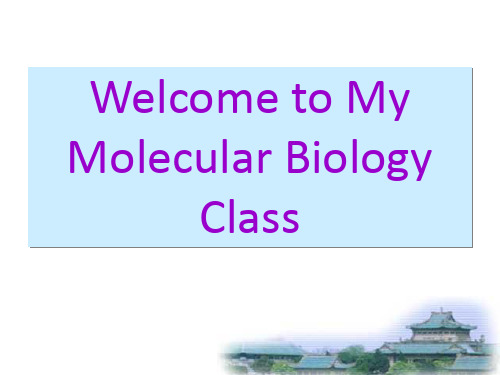
(And some phenotypes are determined by more than one gene) (The luck of Mendel’s discovery: a simple trait)
Figure 1-2 The inheritance of flower color in the snapdragon (金鱼草).
Chapter 2: Nucleic Acids convey genetic information
The stories/efforts led to the fundamental knowledge of life, which open a new era of modern biology.
By the 1930s, geneticists began speculating as to what sort of molecules could have the kind of stability that the gene demanded, yet be capable of permanent, sudden change to the mutant forms that must provide the basis of evolution... It was generally assumed that genes would be composed of amino acids because, at that time, they appeared to be the only biomolecules with sufficient complexity to convey genetic information. This hypothesis is eventually dead from its shaking base and attractive complexity.
Figure 1-2 The inheritance of flower color in the snapdragon (金鱼草).
Chapter 2: Nucleic Acids convey genetic information
The stories/efforts led to the fundamental knowledge of life, which open a new era of modern biology.
By the 1930s, geneticists began speculating as to what sort of molecules could have the kind of stability that the gene demanded, yet be capable of permanent, sudden change to the mutant forms that must provide the basis of evolution... It was generally assumed that genes would be composed of amino acids because, at that time, they appeared to be the only biomolecules with sufficient complexity to convey genetic information. This hypothesis is eventually dead from its shaking base and attractive complexity.
分子生物学英文课件:Chapter12 Regulation of metabolism
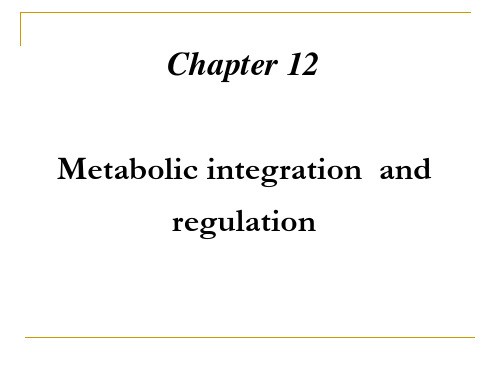
1. Heart (aerobic oxidation) The heart uses a variety of fuels: fatty acids, ketone
bodies, lactate, glucose. 2. Brain Under normal conditions the brain only uses blood glucose. During fasting uses ketone bodies. 3. Muscle Glycogenesis and stores Phosphocreatin, Glycogenolysis, FA oxidation to provide energy lacks glucose –6-phosphatase, cannot release free Glc
Satiation → Insulin↑ glucagon↓ (1) Glucose supply energy; (2) Glucose → Glycogen (liver, muscle); (3) Glucose →TG (VLDL)
2. Fasting
(1) After eating 6~8h, Liver glycogenolysis↑
6. Kidney Gluconeogenesis
SectionⅤ. Regulation of metabolism Metabolic regulation at different levels:
at cell level (original) at hormone level at entirety level
metabolic character 4. Common metabolic pool 5. ATP is the common form for energy storage
bodies, lactate, glucose. 2. Brain Under normal conditions the brain only uses blood glucose. During fasting uses ketone bodies. 3. Muscle Glycogenesis and stores Phosphocreatin, Glycogenolysis, FA oxidation to provide energy lacks glucose –6-phosphatase, cannot release free Glc
Satiation → Insulin↑ glucagon↓ (1) Glucose supply energy; (2) Glucose → Glycogen (liver, muscle); (3) Glucose →TG (VLDL)
2. Fasting
(1) After eating 6~8h, Liver glycogenolysis↑
6. Kidney Gluconeogenesis
SectionⅤ. Regulation of metabolism Metabolic regulation at different levels:
at cell level (original) at hormone level at entirety level
metabolic character 4. Common metabolic pool 5. ATP is the common form for energy storage
